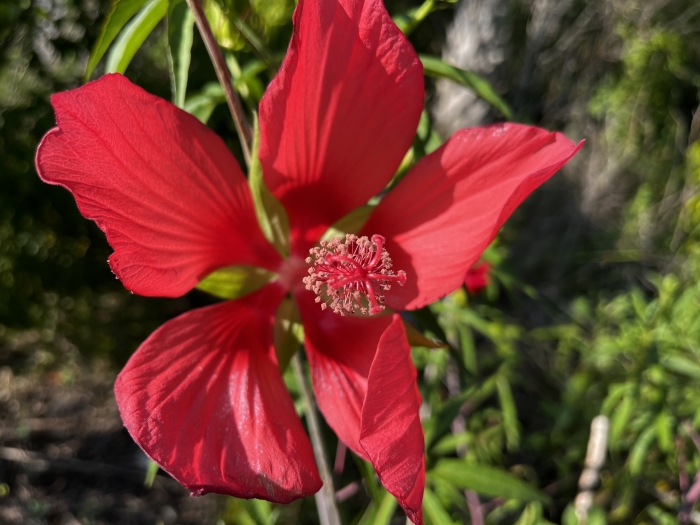Scarlet Rosemallow
(Hibiscus coccineus)
Scarlet Rosemallow (Hibiscus coccineus)
/
/

Dmitry Podobreev
CC BY 4.0
Image By:
Dmitry Podobreev
Recorded By:
Copyright:
CC BY 4.0
Copyright Notice:
Photo by: Dmitry Podobreev | License Type: CC BY 4.0 | License URL: http://creativecommons.org/licenses/by/4.0/ | Rights Holder: Dmitry Podobreev | Publisher: iNaturalist | Date Created: 2023-06-11T23:00Z |















































Estimated Native Range
Summary
Hibiscus coccineus, commonly known as Scarlet Rosemallow or Texas Star, is a herbaceous perennial native to the wetlands and marshy areas of the southeastern United States along the Gulf Coast. It typically grows 6-8 feet tall and can spread 3-4 feet wide. The plant’s notable features include its bright scarlet, star-shaped flowers that bloom from mid-summer to early fall, which are particularly showy and attract hummingbirds, butterflies, and bees. The foliage is deep green and can provide a lush backdrop for the vibrant flowers.
Scarlet Rosemallow is valued for its striking appearance and its role in supporting pollinators. It is often used in water gardens, as a specimen plant, or in naturalized areas where its moisture requirements can be met. It prefers full sun but can tolerate part shade, especially in hot climates. While it thrives in moist to wet soils, it is relatively adaptable and can withstand short periods of drought once established. It is hardy in USDA zones 6-9. Gardeners should be aware that it can be susceptible to rust, leaf spots, and aphids. Despite these potential issues, its ease of maintenance and spectacular flowers make it a favorite among gardeners.CC BY-SA 4.0
Scarlet Rosemallow is valued for its striking appearance and its role in supporting pollinators. It is often used in water gardens, as a specimen plant, or in naturalized areas where its moisture requirements can be met. It prefers full sun but can tolerate part shade, especially in hot climates. While it thrives in moist to wet soils, it is relatively adaptable and can withstand short periods of drought once established. It is hardy in USDA zones 6-9. Gardeners should be aware that it can be susceptible to rust, leaf spots, and aphids. Despite these potential issues, its ease of maintenance and spectacular flowers make it a favorite among gardeners.CC BY-SA 4.0
Plant Description
- Plant Type: Herb, Shrub
- Height: 6-8 feet
- Width: 2-3 feet
- Growth Rate: Moderate
- Flower Color: Red
- Flowering Season: Spring, Summer, Fall
- Leaf Retention: Deciduous
Growth Requirements
- Sun: Full Sun, Part Shade
- Water: Medium, High
- Drainage: Medium, Slow
Common Uses
Bird Garden, Butterfly Garden, Hummingbird Garden, Low Maintenance, Street Planting, Water Garden
Natural Habitat
native to the wetlands and marshy areas of the southeastern United States along the Gulf Coast
Other Names
Common Names: Swamp Hibiscus , Texas Star
Scientific Names: Hibiscus coccineus , Hibiscus semilobatus , Malvaviscus coccineus
GBIF Accepted Name: